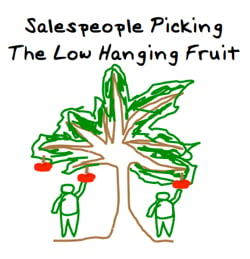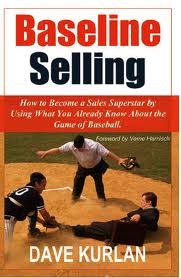The following is a true story. A few names have been changed to protect the identity of some of the people involved.
The Element of Luck in Selling
Luck is an element in every sales person’s career, you may get assigned a territory when a major propsect or customer is in the right moment of a purchasing cycle to need you and your capabilities and you step up and make the sale... the hero of the hour.
Unless you are working in an early stage technology company, you can bet that the territory you have been assigned has had the low hanging fruit plucked by your predecessor, or if it’s a new territory carved off an existing sales person’s territory…. It’s been well worked for opportunity.
that the territory you have been assigned has had the low hanging fruit plucked by your predecessor, or if it’s a new territory carved off an existing sales person’s territory…. It’s been well worked for opportunity.
In my sales career, I’ve been lucky several times to land a territory where a good salesperson had been developing opportunity and was promoted out of the role and I stepped in. In these cases success came quickly….but that was not the case on joining MSTR.
Rule: expect nothing from your new territory, it’s the opportunity that you personally create, that you get to harvest, anything more than that is luck.
I was hired into MicroStrategy (MSTR) from Informix Software, where I met Sid Bannerjee and members of the MicroStrategy West Coast sales team. I happily introduced them and they were successful selling into some of my retail accounts – we needed applications to run on the Informix data warehouse software.
Sanju Bansal, COO of MicroStrategy interviewed me and asked me to come on board. He said they needed an experienced salesperson with “some brass” to go after the major relational database companies with the goal of partnering and getting them to resell MicroStrategy software and so began a 6 year stint with MicroStrategy.
Rules for anyone thinking of going into OEM sales.
Creating OEM partnerships with big fish like MicroSoft, IBM and NCR Teradata can take years, therefore:
- Park your ego at the door; you are an orchestrator and part of a bigger team than in direct sales.
- Be prepared for the long haul, it could take hundreds of calls and meetings to get there.
- Make sure you have the support of your management and their commitment to back you through a multi-year journey.
- Negotiate a comp plan based on MBO’s, not revenue, or you may starve in the first year or two.
Scorched Earth
Several times during my career I have also had the misfortune of inheriting a territory where my predecessor had actually harmed the relationship and created adversaries in the prospective customer base.
It happened to me at Sun in the UK at a meeting with top FOREX broker, Tullet & Tokyo, when Sun workstations were selling by the semi-trailer load for Trading room workstation applications. I well remember pulling the gas relief valve on my chair and sinking slowly under the table for some comic relief, when the IT director told us that he would never buy from Sun, thanks to my predecessor Dan and his mate, an underling at Tullet and Tokyo, who had totally botched an executive level relationship, between the Sun MD, Bill Passmore and their CEO.
And it happened at MicroStrategy.
My predecessor had developed a strong adversarial relationship with his counterpart at NCR and they had spent a year prior to my arrival, not negotiating a joint marketing agreement. The problem was that he was now my boss and the adversarial relationship continued.
It became clear to me that I had to outmaneuver my boss and his counterpart before we were going to make progress with NCR and so I wangled a transfer to a new manager, Scott Hughes, who was running the VAR program and things improved rapidly from that point for me. Similarly, NCR appointed a new relationship manager and we eventually signed a joint marketing agreement.
Building a Relationship, brick by brick
Creating an OEM partnership with the behemoths of the industry is like building a house, brick by brick. Every meeting is another brick in a wall, a step forward hopefully. Sometimes set-backs occur.
I recall a meeting with MSTR CEO Mike Saylor with the NCR technical leadership in San Diego, when they told us that they were developing their own in-house OLAP product, which they were calling Teracube and we left the room with our butts on a plate. I found out why they were building their own product a year later in a revelation that for some reason had not been shared with me.
Despite the fact that the NCR Teradata team were developing a competing product, the Teradata Retail team was selling big Teradata Data Warehouse systems into major retailers for SKU level analytics and their customers wanted MicroStrategy for the decision support front-end.
Eventually after more than two years, numerous set-backs and a hundred or more calls and meetings, we inked a Value-added reseller agreement.
Click here to read Part 2. Defeat
Join us for our Webinar - How to Create Visual Confections that Sell



